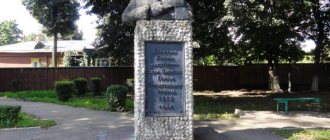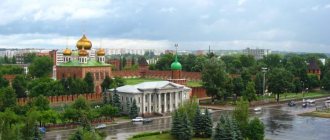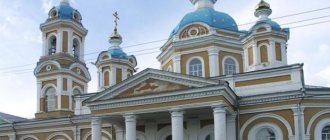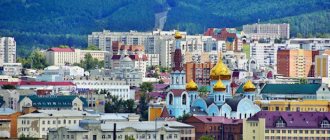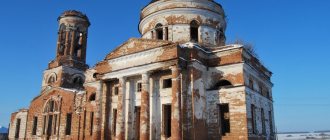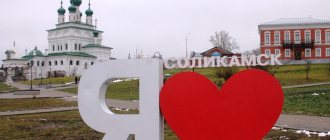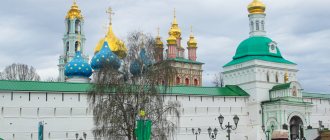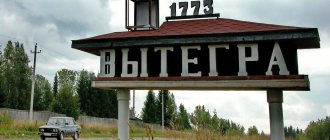Pavlovsky Posad is a cozy old provincial town in the Moscow region. The sights of Pavlovsky Posad are represented by ancient architectural monuments, wooden buildings, natural objects and, of course, painted scarves that warm you up in any cold weather, for which a special museum has been created to display.
In the XIV century. The outskirts of the city were called Vokhonsky volost. Its center was considered the village of Vokhna, which also had the second name Pavlovo. In those days, all this was the property of Prince Dmitry Donskoy.
During the period of hostilities in 1812, a partisan movement developed in these places. This event is immortalized in a monument to its leader, peasant Gerasim Kurin.
A few facts about Pavlovsky Posad
- Mentioned for the first time in 1339 in the spiritual letter of I. Kalita as Pavlovo (Vohna)
- Received the status of a city called Pavlovsky Posad with several villages included in its composition in 1844 by decree of Tsar Nicholas I.
- Actor Vyacheslav Tikhonov and cosmonaut Valery Bykovsky were born in Pavlovsky Posad.
- The population of the city is about 65 thousand people
- Distance from Moscow by highway – 76 km
- The railway station of the same name is located just over 67 km from the Kursky station.
In this area, work is underway to create an open-air museum, which the city should become. So the sights of Pavlovsky Posad are worth seeing.
The main attractions of Noginsk.
How to get to Pavlovsky Posad
From Kursky Station in Moscow you can get to Pavlovsky Posad by train. Through the city there is a path to Petushki, Krutoye, Elektrogorsk, Vladimir and Orekhovo-Zuevo. Departures are every 15-30 minutes, travel time is about 1 hour 30 minutes. The fare is approximately 208 RUB. Prices on the page are for April 2022.
You can also come from the capital to Pavlovsky Posad by bus - from the Partizanskaya metro station to the place there is number 386 (Moscow - Pavlovsky Posad). It takes about 2 hours, the ticket costs around 200 RUB.
There are three travel options by private vehicle. The first is to drive along the Gorkovskoye Highway and after Noginsk in the village of Kuznetsy, turn right at the traffic light. The disadvantage of this route is traffic jams and poor quality of the road surface. There is a good road on Nosovikhinskoye Highway, but there are many railway crossings on this route. Another way is through Lyubertsy and Yegoryevskoye Highway. In any case, the distance is about 80 km, but the travel time due to waiting in traffic jams and at railway crossings can last for 2 hours.
Intercession-Vasilievsky Monastery
The sights of Pavlovsky Posad and memorable places of the city open up to tourists literally immediately upon arrival. This list begins with the Pokrovo-Vasilievsky Monastery, founded by local manufacturer Yakov Labzin, who at one time produced scarves.
It was he who built the first two-story church over the graves of his wife Akilina Ivanovna and companion Vasily Gryaznov, which was the beginning of the organization of the monastery. Subsequently, an almshouse was opened at the temple, which was later transformed into a convent.
Unfortunately, during the Soviet period, when there was an active struggle against the church, the monastery was closed, and it was decided to use its buildings as garages and warehouses.
This situation changed only in 1989. Then they began to restore the monastery, recreating a monastery on the basis of the old buildings. Now it contains particles of the relics of saints, as well as ancient icons.
PAVLOVSKY POSAD
PAVLOVSKY POSAD, a city in Russia, in the eastern part of the Moscow region, the center of the urban district of the same name. Population 63.6 thousand people. (2019). Located on the river. Klyazma, at the confluence of the river. Vokhonka (Vohna). Railroad station. The Volga federal highway (Moscow – Vladimir – Nizhny Novgorod – Kazan – Ufa) runs 6 km north of P.P.
Story
It arose on the territory of the Vokhna volost, which was first mentioned in 1336 in the first spiritual charter of the Grand Duke of Vladimir Ivan I Danilovich Kalita. In the 1570s – 1764 patrimony of the Trinity-Sergius Monastery. In 1585/86, in the scribe book of the Moscow district as part of the Vokhna volost, the Dmitrievsky churchyard and the village of Pavlovo were first mentioned, which by the mid-1640s. merged into Pavlovo (Vohna), which became the center of the surrounding lands. Since 1764 it has been a state village. From the 18th century Peasant weaving enterprises opened in Pavlov, local peasants Labzins, Shirokovs, Shchepetelnikovs and others became large entrepreneurs. From the end of the 18th century. center for the production of Pavlovsk scarves. During the Patriotic War of 1812, partisans and fighting squads were active in the village and its environs. In 1839–45, the Moscow–Nizhny Novgorod highway, which ran near Pavlov, was built. By decree of Emperor Nicholas I dated June 2(14), 1844, the unification of the village. Pavlovsky settlement was formed in Pavlovo (Vokhna) and the villages of Dubrovo, Zakharovo, Melenki and Usovo. It received simplified city government, but until 1917 it had the official status of a settlement. In 1861, traffic was opened along the Moscow-Vladimir railway line that ran directly next to the settlement. By the beginning of the 20th century. Pavlovsky Posad is one of the important centers of textile production in the Moscow region, among the largest enterprises are the factories of the Russian-French Anonymous Society of Cotton Manufactory, the factories of the Partnership of Y. Labzin and V. Gryaznov (now the Pavlov Posad Shawl Manufactory), etc. The city since 1917 (without official registration; legislative status was enshrined in 1925). On October 26 (November 8), 1917, Soviet power was established. During the Great Patriotic War, the textile enterprises of Pavlovsk Posad were converted to produce products for the front: uniforms, raincoats, parachute fabric, etc. District center (1929–59, 1965–2017) of the Moscow region. In 1959–65, it was part of the Noginsk district of the Moscow region. In 1990–2010 it had the status of a historical city of Russia. City of regional subordination (1939–2001, since 2017). From 2022 the center of the city district of the same name.
Architecture
Pavlovsky Posad. Church of the Intercession of the Blessed Virgin Mary of the Intercession-Vasilievsky Monastery. 1870–72. Refectory and bell tower – 1907–10. Photo by Yu. A. Demidova.
In the central part of Pavlovsky Posad (on the right bank of the Klyazma), a regular layout has been preserved (it began to take shape around 1840, the plan was approved in 1887) and partially the buildings of the mid-19th - early 20th centuries. On the right bank of the Vokhonka, on Voskresenskaya (formerly Bazarnaya) Square, the classicist house of the merchant D.I. Shirokov (late 1830s; now the Exhibition Hall) has been preserved; near the square - the Ryazankin estate (1830–40s), a church in honor of the Kazan Icon of the Mother of God (1900s, the top was restored in 2007). Also preserved are: the building of the factory of T-va Ya. Labzin and V. Gryaznov, a number of private houses of the late 19th - early 20th centuries; the building of the Vulcan cinema in the spirit of neoclassicism (early 20th century); wooden houses with carvings from the 19th – 1st half of the 20th centuries. (including the house in which actor V.V. Tikhonov was born). In the southern part of the city there is a quarter of factories of the Russian-French anonymous joint-stock company (late 19th - early 20th centuries).
In Zarechye (on the left bank of the Vokhonka), in the former Dmitrievsky churchyard, there is one of the main architectural dominants, the empire-style 4-tier bell tower (1838–41) of the Resurrection Church (1703, destroyed in the 1940s). Next to it is the Church of St. Nicholas (1914). In Zarechye there is also a chapel in memory of the deliverance from the French invasion in 1812 (1912, architect V.K. Serotsinsky; destroyed in 1932, restored in 2007–08). On the northern outskirts of the city is the Intercession-Vasilevsky Monastery (since 1903; closed in 1920, revived in 1995) with the churches of the Intercession of the Blessed Virgin Mary (1870–72; the lower church of St. Basil the Confessor was consecrated in 1874; the refectory and bell tower in the Russian style - 1907 –10, architect V. P. Desyatov) and St. John the Baptist (2000s). In the former village The town, on the left bank of the Klyazma, is a 4-pillar Ascension Church in the neo-Byzantine style (1908, architect Desyatov). Old Believer Church of the Nativity of the Virgin Mary in the former village. Kornevo (1997).
15 km southeast of Pavlovsky Posad, in the village. Novozagarye, - Assumption Church in the Peter the Great Baroque style (1714–15, rebuilt in the Empire style in 1844, architect A. G. Grigoriev; refectory and bell tower in the Russian style, 1906–11, architect V. P. Desyatov).
Centers of science and culture
Branches of universities: Russian State Social University, Modern Academy of Humanities, Russian State Humanitarian University, Russian International Academy of Tourism. History and Art Museum (1971; in a wooden building from the early 20th century; collection of scarves).
Farm
Light industry is traditionally important: the Pavlovo Posad Shawl Manufactory (1795) produces over 400 types of shawls, shawls, scarves, mufflers, stoles, tablecloths made of wool, cotton, and silk; “Pavlovo Posad Worsted Man” (1864) – over 100 items of wool blend fabrics; “Pavlovo Posad silk” (1812) – decorative fabrics for various purposes (including curtains, church fabrics, lining, furniture). Production of electronic products (Exciton), cast-insulated conductors (RTK-Electro-M), fire extinguishers and fire hoses (Bereg; 1929), paints and varnishes (BASF Vostok), liquid detergents (Ton "; 1997), cardboard containers (Pavlovo-Posad Corrugated Corrugated Plant), paper hygiene products (Papyrus), kitchen furniture (Diamant-Pro), aluminum profiles (International Aluminum Company; 2002), ceramic bricks ( “Pavlovskaya Ceramics”, 1889), ceramic and porcelain dishes (“Ceramic Manufactory”), garments (“Thermoline”), sports equipment and inventory (“Dynamics Sports Equipment Plant”; 2019).
Resurrection Cathedral
This religious building is one of the oldest buildings in Pavlovsky Posad. The time of its construction dates back to the beginning of the 18th century, when a stone structure was erected on the site of the Church of St. George the Victorious that stood here.
At first it was just a 5-domed church with a refectory, but in the 19th century. it was completely reconstructed, first erecting a new refectory, and then adding two chapels to it: Dmitrievsky and Sergievsky and a high bell tower.
The reconstruction of the temple lasted for almost 4 decades, and ended only in 1875, when a dome was installed over the refectory.
Unfortunately, the building of the Resurrection Cathedral could not survive the difficult times of the anti-church struggle of the Soviet rulers. It was first closed in 1936, and in the early 1950s it was completely demolished. Of the entire cult complex, only the bell tower has survived to this day, rising on a hill and serving as a real decoration of Pavlovsky Posad.
Transport
In Pavlovsky Posad, buses and minibuses run on 9 city routes. When paying with the unified transport card for the Moscow region "Strelka", you can save 30% on each trip.
Several taxi companies transport passengers around the clock. A taxi ride within the city will cost no more than 150-200 RUB.
Pavlovsky Posad is relatively small in size, so leisurely walks and bike rides are the best way to get to know it. You can rent a bike not far from the Park of Culture and Recreation - in the Gourmet cafe. You must leave an identification document as collateral.
Museum of Local Lore
Website: ppmvk.ru Address: st. B. Pokrovskaya, 38
This cultural institution was organized in November 1971 and was initially located in the bell tower, which was preserved after the demolition of the Resurrection Cathedral. 32 years later, in 2003, it was renamed the Historical and Art Museum and moved to another building, more suitable for these purposes.
Now this museum has several permanent exhibitions telling about handicrafts, the city itself, and the history of the production of unique Pavlovsk scarves.
Among the exhibited items are materials from archaeological excavations, wooden figurines of townsmen craftsmen, several hundred samples of locally produced fabrics and shawls, and even a spacesuit that belonged to cosmonaut V.F. Bykovsky.
One of the newest exhibitions is dedicated to the life and work of film actor V. Tikhonov, People's Artist of the USSR, born in Pavlovsky Posad.
Pavlovsky Posad – what to see in one day
- If you have only one day to see all the interesting places of Pavlovsky Posad, you should start getting acquainted with it by walking through the streets of the city .
- After passing through the central park , you can get to the local history museum and even take a photo with the Eiffel Tower , located nearby. A smaller copy of the French namesake was built back in Soviet times.
Museum of Local Lore
Did you know? Pavlovsky Posad has not only its own Eiffel Tower, but also Paris - not a city in miniature, but one of the districts, next to a weaving factory.
- After the museum, it’s worth taking a walk along Bolshaya Pokrovskaya , the main historical street of the city. It will lead to Revolution Square, from where you can see the Church of the Icon of Our Lady of Kazan. In the northern part of the square there is a monument to the founding of Pavlovsky Posad.
- If you return from the square to Lev Tolstoy Street, you can get to the bell tower of the Resurrection Cathedral .
- Don't forget to visit the Museum of the History of Scarves and Shawls , as well as the Pokrovsko-Vasilievsky Monastery .
Fire station with watchtower
While viewing the sights of Pavlovsky Posad, you cannot pass by one of the oldest buildings in the city - the fire station with a tower towering above it. The construction of this very important structure for the city was completed in 1870.
Of interest to modern people is the building itself, which is an octagonal 3-story tower with an observation deck for monitoring the situation.
Starting in 1999, the Firefighting Museum was organized in the depot building, which lasted for 4 years. In 2003, it was disbanded, and its exhibits were transferred to the exhibition of the city local history museum.
Shirokov's House
Another interesting architectural monument within the city is a two-story mansion built at the turn of the 1830s-1840s by local manufacturer Davyd Shirokov.
The mansion, built of brick, with original plaster finishing, became a reference for the city, and many other buildings in the central part of Pavlovsky Posad were subsequently built according to its model.
The personality of Shirokov himself is also of interest. He was the son of a local peasant, but thanks to his own efforts he was able to achieve the civil rank of merchant of the 1st guild. This man was the initiator of the idea of creating a city from a group of surrounding villages, and then built as many as 2 factories in it, which employed about 800 workers. Davyd Ivanovich bequeathed the house he built for himself to the city.
After his death, the building housed the city hospital, and now there is an exhibition hall “Shirokov’s House”.
Shchepetilnikov House
An excellent example of urban architecture of the mid-19th century is a large two-story house built by the merchant of the III guild R. L. Shchepetilnikov. The complex consists of a residential building itself and a long row of courtyard buildings.
The work was carried out taking into account the “model project”, which began with the building of another merchant, Davyd Shirokov. But unlike its ancestor, the layout of the interior rooms in Shchepetilnikov’s house has been preserved almost completely intact.
The main change to the outer part of the building was the courtyard extension, made in the mid-twentieth century. in order to increase the number of internal premises.
All outbuildings are made in the form of wooden log houses and are placed under a single roof. The personality of the owner of the house is also interesting. The merchant came from the Old Believers and was engaged in the production of silk and cotton fabrics.
The main change to the outer part of the building was the courtyard extension, made in the mid-twentieth century. in order to increase the number of internal premises. All outbuildings are made in the form of wooden log houses and are placed under a single roof. The personality of the owner of the house is also interesting. The merchant came from the Old Believers and was engaged in the production of silk and cotton fabrics.
What to bring
During the reign of Nicholas I, one of the very first large textile factories in the Russian Empire was founded, specializing in the production of silk and woolen scarves - today the products of this enterprise are the hallmark of Pavlovsky Posad, and the scarf is even depicted on the city coat of arms (website). Everyone who has visited these parts buys several scarves at once as a souvenir, because they are all so beautiful and original that it is difficult to choose just one. You can buy real Pavlovo Posad shawls in the same place where they are made - in a specialized store at the Pavlovo Posad Shawl Manufactory (Kalyaeva St., 5).
Museum of the History of Russian Shawls
Website: muzeyplatka.mo. Address: st. Bolshaya Pokrovskaya, 37, recreation center "Pavlovo-Pokrovsky" (Entrance from the shopping center). Opening hours: from 10.00 to 17.00, closed on Monday; last Friday of the month (sanitary day). Ticket price: 100 rubles, students, schoolchildren and pensioners - 50 rubles.
Considering that the main glory of Pavlovsky Posad came from the production of original scarves, it would be surprising if it did not have an establishment dedicated to this craft.
The Museum of the History of the Russian Scarf and Shawl was created in the spring of 2002, and the building of the Pavlovo-Pokrovsky Palace of Culture, which now has almost 90 years of history, was chosen as its location.
The initiator of the creation was local resident V.F. Shishenin, who had long been a member of a group of fine art collectors. It was his collection of household items, women's hats, shawls and scarves from the 18th-20th centuries. and became the basis of the museum exhibition.
Nowadays there are over 400 items on display here, among which are unique hand-printed woolen items.
Holidays and Events
Pavlovsky Posad is rich in events and holidays, which are celebrated on a grand scale and inventively. On the first Saturday of June, the Patterned Scarf Festival is held here. In August, volunteer groups of various types gather for the Good Deed festival of goodness and friends. In the Year of Cinema, the International Film Festival “17 Moments...” named after. V. Tikhonova. The first event is scheduled for April 2022. Prizes are expected to be awarded for the best domestic TV series, feature films for children, youth and documentaries.
Kholodets fun awaits guests in February at the unusual Russian Jellied festival, which takes place on the territory of the Princely Dvor museum complex in the village of Bolshie Dvory. The delicious philosophy of eggs will be discussed at the same Princely Courtyard during the Easter season - this is the time of the philosophical and culinary “Eggfest”. The museum complex organizes the Music Festival of Living History “Blagofest” in September, dedicated to A. Nevsky and D. Moskovsky. The festival program includes performances by musical groups - from folk to rock, historical reconstruction, as well as craft master classes for children and adults.
House-Museum of Vyacheslav Tikhonov
The most famous intelligence officer of Soviet cinema, known as Stirlitz, film actor Vyacheslav Tikhonov was born and trained in Pavlovsky Posad.
Now, thanks to the efforts of his daughter, the local administration and the regional governor, a museum has appeared in the house where he lived in his early years. Before it could be organized, the building had to be purchased from the new owner, and then the exhibition had to be assembled for a long time and meticulously in order to most accurately reflect the spirit of the era in which the brilliant artist lived and worked.
Visitors to the house-museum are presented with rare exhibits: personal belongings, letters, photographs, cinematic costumes and even the script for the film “War and Peace”, on the pages of which there are notes from the famous artist.
Where to go in Pavlovsky Posad with children
- Even small children will probably be interested in visiting the Christmas tree decoration museum , which is located on the territory of the Frost factory in the village of Danilovo. The guides will tell you how Christmas tree decorations came about and how they are made at the factory. Young guests will also appreciate the entertainment program with Father Frost and Snow Maiden in winter or buffoons in summer. Children will also be able to watch how toys are born during a tour of the workshops.
- Boys should definitely be taken to the local history museum , where a collection of miniature tanks is exhibited, but girls will be interested in the museum of scarves and shawls .
- In the summer, you can also visit the ice lake , on the shore of which you can have a small picnic.
- If you don’t have time for this, just take a walk with your children through the city’s central park , where there are attractions.
Museum of Christmas tree decorations Pavlovsky Posad is a town in which the pre-revolutionary atmosphere is still felt, merchant houses have been preserved, and the popularity of folk crafts is gradually being revived. Now they are starting to implement the idea of an open-air museum here.
If you have not been to Pavlovsky Posad yet, be sure to go there and bring an iconic souvenir - a painted scarf. If you have already been to this town, share your impressions in the comments, tell us about the sights that you remember most.
Monument to the founders of Pavlovsky Posad
The original sculptural composition installed in the city in the form of 5 people dressed in ancient costumes is dedicated to an event that happened in 1844, namely the moment of the formation of Pavlovsky Posad. It was then that, by decree of Emperor Nicholas I, four surrounding villages were united into a city.
The figures of the monument themselves are symbols of those villages and folk crafts for which they were famous.
Danilischenskoye Lake
The natural attractions of Pavlovsky Posad are represented by an interesting lake located in close proximity to the city, not far from the village of Zaozerye.
Local belief says that at the bottom of a natural reservoir there is a church that sank in ancient times. In this regard, the lake water is considered sacred, which is why a large number of people come here for Epiphany to take a bath.
True, according to scientists, this lake arose during the glaciation era, and there should not be any buildings on its bottom. However, this does not affect the flow of people who want to swim in the relict reservoir.
